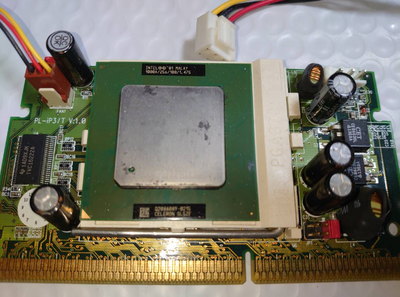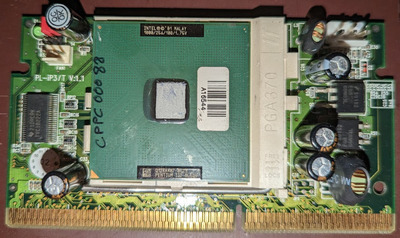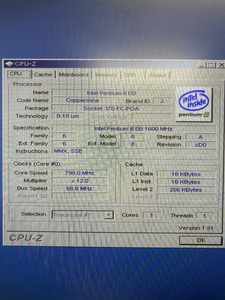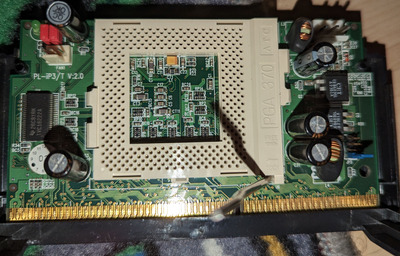First post, by Stevogamer
A few weeks ago I stumbled upon this Japanese article while researching about using slotkets and SMP for my other thread about the Supermicro P6DGE.
Link is in Japanese
http://www9.plala.or.jp/j-fuji/rv226/smp/geta.htm
I was particularly intrigued since the article mentioned that PL-IP3/T's could use coppermines. I thought this certainly wasn't possible.
So I tested the two that I did have. I have a revision 1.1 and a 2.0.
The 2.0 as expected didn't post with a SL5QV installed and the voltage set to 1.75V. But the 1.1 curiously did work. Interestingly the old documentation for early PL-IP3/T's mention a jumper for SMP which I assume is just because Powerleap copy and pasted the PL-IP3 manual and changed the headers to say PL-IP3/T. But considering this does anybody know if SMP worked on the 1.0 revision, since that did have a jumper in place of the blank solder pads with Pin 1 and 2 bridged on Rev. 1.1.
Below are pictures of revision 1.0 and 1.1
Edit: I also recall powerleap's website early on saying it did not support Pentium III-S's so tualatin SMP probably wouldn't be an option on these adapters. And I can confirm that my system was unstable when I did try to use a Pentium III-S 1.4GHz on the Rev 1.1. I was testing it on a BH6 with the SS bios and had the FSB lowered to 100mhz. The only slot 1 board that I have that supports 133mhz is a DFI TA-64B and that didn't like the powerleap at all the FSB was way high. So I assume the Rev 1.1 just doesn't supply the correct voltage.
My Rev 1.1 came with a 1.2GHz Tueleron for reference. My Rev 2.0 interestingly came with a QEJ0ES engineering sample for the Pentium III 1000EB although would that be a Coppermine-T since the 2.0 wouldn't take my normal coppermine? CPU-Z just says Coppermine.
Edit 2: My idea was to desolder the existing bridge and adding jumper pins to have selectable modes just like described in the manual https://web.archive.org/web/20021122174912/ht … ructions%20.PDF
Edit 3: It's also interesting that in a post from 2010 by retro games 100, Powerleap adapter , they say that were able to get a SL5QV working on the 2.0 which matches the Japanese article. But my 2.0 wouldn't POST at all not even with the correct voltage setting. But it worked just fine in my ABIT Slotket !!! (I had to set the voltage, AUTO didn't work) and the 1.1 (Is auto only). I never expected the SL5QV to work on a FC-PGA2 socket anyways but strange that other people did get it working.
Also the only real difference that I can see between the 1.0 and the 1.1 is the use of Chino-Excel transistors on the 1.0 (and all the other common revisions) and Fairchild transistors on the 1.1. The Fairchild transistors seem slightly inferior in spec compared to the Chino-Excel's but not to a significant difference that would make the Pentium III-S's not work. I can't rule out that it is possible that the P3S's just don't work with my BH6. I did try recapping my BH6 which didn't help.
I don't have any other boards on hand at the moment (I have a BE6-II in storage but it needs a recap on the VRM and the DFI just doesn't work with the tualatins) and my Supermicro board is in shipping.
My guess is the SL5QV probably won't work in SMP on the 1.1 since it'll be missing the 56ohm pullup resistor required for coppermines but it will work with tualatins since the spec said it didn't need the pullup resistors. I'll be testing this in a few months once my motherboard arrives but I figured this info could be useful for others as well.
https://web.archive.org/web/20210802085908/ht … ime/slotket.htm



